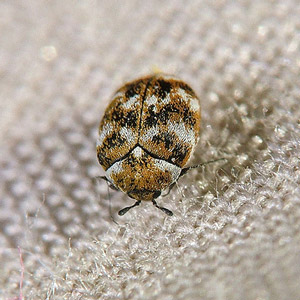Carpet Beetles Are Not Just in Carpets
By Chris Williams on November 6, 2013.
 Question
Question
We recently had a terrible infestation of carpet beetles in our home, but they weren’t infesting the carpets or any woolens that we could find. We never did find where they were coming from. I’d like to find the source so we could prevent a reoccurrence. Any ideas?
Answer
Tiny carpet beetles (dermestids) feed on many different things, both plant and animal in origin, so sometimes you have to look beyond the obvious. In nature, carpet beetles recycle animal matter, feeding on dead animals and insects, shed hair, and feathers. In homes, the source of occasional carpet beetles is often an accumulation of lint, food crumbs, dead insects, and animal hair that collects in corners, under furniture, or in seldom cleaned areas. Major carpet beetle infestations with lots of beetles emerging all at once are usually traced to an animal carcass like a dead raccoon in a chimney or a dead squirrel in the attic.
If your beetles were infesting a carcass in a wall void or other space, in most cases, you would have smelled the decay. But if you’ve had no new beetles appearing lately, that may have been the source which has now been depleted and may never be found.
Carpet beetle adults are small, rounded and often calico colored. The larvae are brownish, hairy, and active. The larvae avoid light and are usually found in dark, protected places. An infestation may start in one location, like an animal carcass, but emerging adult beetles can then lay eggs in other places in a home. While the beetle larvae are often found in animal carcasses, or in animal nests, they can also infest food products, and many other items.
Sources of Carpet Beetle Infestations
- Rodent infestation
- Bird nests
- Animals nesting in attic, crawlspace, or chimney
- Dead animal in wall or ceiling void or other space
- Roosting bats
- Wasp and bee nests
- Wool rugs and blankets
- Stored woolen clothing
- Piano felts, felt backing
- Lint and debris in floor cracks, baseboards, vents, etc.
- Accumulations of pet hair
- Mounted animal trophies
- Down pillows and comforters
- Upholstered furniture
- Silk, fur, mohair items
- Seeds and pet food
- Cereal, meal, flour food products
- Rodent bait